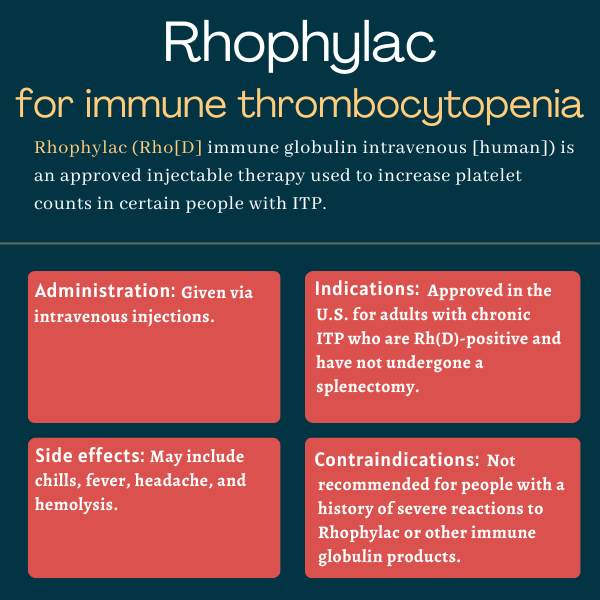
Rhophylac (Rho[D] intravenous immune globulin [human]) for immune thrombocytopenia
Last updated July 10, 2025, by Lindsey Shapiro, PhD

What is Rhophylac for immune thrombocytopenia?
Rhophylac (Rho[D] immune globulin intravenous [human]) is an approved therapy used to raise platelet counts in adults with chronic immune thrombocytopenia (ITP) who have not undergone a splenectomy, or a surgical procedure to remove the spleen.
It’s given via intravenous injections, administered directly into the bloodstream, to reduce the risk of bleeding events in people with ITP.
ITP is characterized by the destruction of healthy platelets — cell fragments needed for blood to clot — due to misguided immune attacks. Self-reactive antibodies bind to the platelets and mark them for destruction, which is mainly done by immune cells called macrophages in the spleen.
It is not exactly established how Rhophylac works in ITP, but it’s thought to occupy these macrophages so that they’re not available to attack the antibody-coated platelets. That allows the platelets to survive longer.
The medication contains antibodies (immune globulins) from human blood that are targeted against Rh(D). This protein is found on the surface of red blood cells and helps determine a person’s blood type — for example, someone with AB-positive blood has the Rh(D) protein, while someone who’s AB-negative does not. When the antibodies in Rhophylac coat Rh(D)-positive red blood cells, it prompts macrophages to bind to them, leaving the immune cells too busy to attack platelets.
Rhophylac is marketed by CSL Behring. It can also be used to prevent immune reactions in certain Rh(D)-negative people who are exposed to Rh(D)-positive blood.
Therapy snapshot
| Brand name: | Rhophylac |
| Chemical name: | Rho(D) immune globulin intravenous (human) |
| Usage: | Used to increase platelet counts in some adults with chronic ITP |
| Administration: | Intravenous injection |
Who with immune thrombocytopenia can take Rhophylac?
Rhophylac is approved in the U.S. as a treatment to raise platelet counts in adults with chronic ITP who have an intact spleen and are Rh(D)-positive.
Because the therapy directs the immune system against red blood cells, it can lead to a complication called intravascular hemolysis (IVH) in people with ITP. In IVH, red blood cells within blood vessels are destroyed. Given this potential complication, Rhophylac’s label comes with a boxed warning for IVH, which can have serious and life-threatening consequences.
Rhophylac is contraindicated, or should not be used, for:
- people with a history of anaphylaxis (a severe allergic reaction) or severe systemic reactions to human immune globulin products
- anyone deficient in IgA antibodies who has developed anti-IgA antibodies and has a history of hypersensitivity reactions (unwanted, adverse immune responses) to Rhophylac or any of its components.
How is Rhophylac administered in immune thrombocytopenia?
Rhophylac is given via weight-based intravenous injections that are administered by a healthcare provider.
The injection itself takes only a few minutes, but patients will be monitored for at least eight hours afterward for potential IVH complications.

Rhophylac in immune thrombocytopenia clinical trials
Rhophylac’s approval for ITP was mainly supported by an open-label Phase 3 trial involving 98 Rh(D)-positive adults with chronic ITP, all of whom received a single dose of the therapy. The data were positive.
- Rhophylac led to a meaningful increase in platelet counts for about two-thirds of participants within two weeks of treatment.
- The mean time to a platelet response was three days, and the mean response duration was about three weeks.
- Nearly 90% of patients who were experiencing bleeding at the study’s start had a regression of bleeding during the study, with the percentage of participants without bleeding increasing from 49% to 70.4% after eight days.
Common side effects of Rhophylac
The most common side effects of Rhophylac reported in people with ITP are:
- chills
- fever or increased body temperature
- headache
- hemolysis, or red blood cell destruction.
Rhophylac comes with a boxed warning for IVH, which can lead to complications such as severe anemia, or low levels of red blood cells, organ failure, or disseminated intravascular coagulation, a serious abnormal blood clotting response. Rare cases of fatal IVH have occurred in ITP patients treated with medications in this class.
Patients should be monitored in a healthcare setting for at least eight hours after an injection. Once at home, they should continue to self-monitor for signs of IVH at any time. Among the potential signs are back pain, shaking chills, fever, discolored urine, and decreased urine output.
Other possible side effects associated with Rhophylac, which may be serious, include:
- severe hypersensitivity reactions, including anaphylaxis
- transmission of infectious agents, because the treatment comes from human blood
- worsening anemia in people with pre-existing anemia.
Bleeding Disorders News is strictly a news and information website about the disease. It does not provide medical advice, diagnosis, or treatment. This content is not intended to be a substitute for professional medical advice, diagnosis, or treatment. Always seek the advice of your physician or other qualified health provider with any questions you may have regarding a medical condition. Never disregard professional medical advice or delay in seeking it because of something you have read on this website.
Recent Posts
- ITP treatment Doptelet may help prevent bone loss in osteoporosis
- Bleeding risk high soon after kidney transplant in VWD, hemophilia A
- Combined therapy aids recovery for woman with TTP and lupus
- An ITP diagnosis wasn’t the final word on my health setbacks
- Cell therapy QT-019B shows strong response rate in hard-to-treat ITP
Related articles
-

-
-

THROMBOTIC THROMBOCYTOPENIC PURPURA
NewsCombined therapy aids recovery for woman with TTP and lupus
-
-
-




